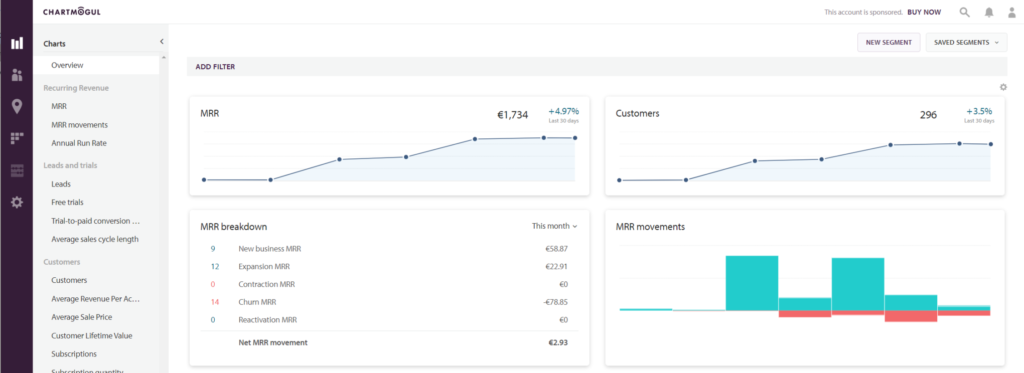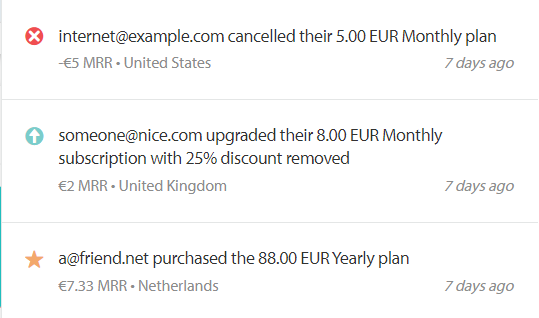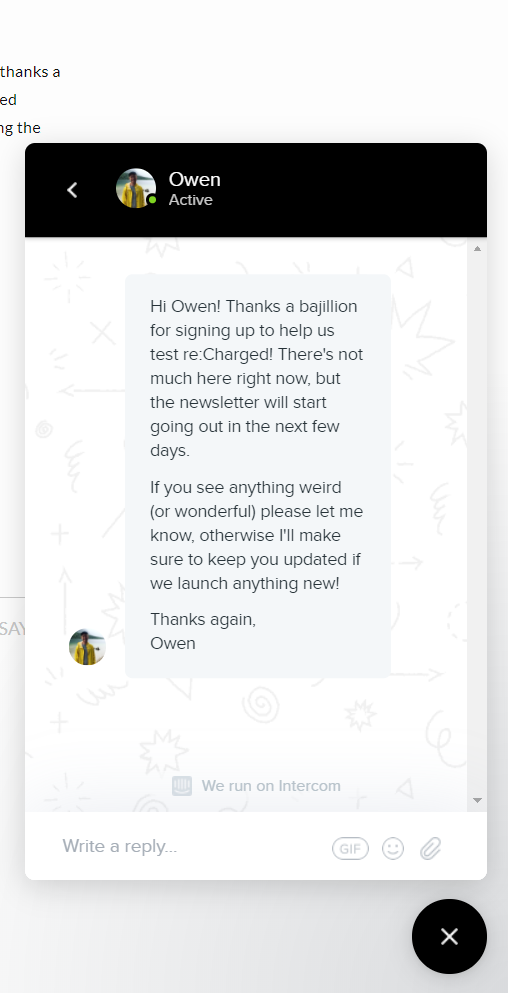Late last year, I started building reCharged, a daily briefing and community designed as the antithesis of traditional news. The briefing is delivered each morning on weekdays, doesn’t worry about breaking news, and has no advertising. I coded the software that wires it up, sends the newsletter and gives users access to the community — as well as being the solo-writer behind the content each day.
I started the project with the goal of making a little bit of money, but not intending for it to be a full-time focus for at least a few months — basically my side project for experimenting with generating revenue for the first time. I wouldn’t be spending any money on it, just my time, to see if it was worth pursuing.
“…every day is an adventure, but a nightmare too: what should I focus on to be effective?”
When I launched into beta, on what I’d say was just enough of a working product to scrape by, I found myself surprised: 20 people showed up and started paying for it, even though it was unstable. Fast-forward five months to today, and I’m sending those briefings four days a week to about 300 paying subscribers and $1,800 MRR — utterly terrifying, thrilling, and not what I expected at all.
The rollercoaster of building your own product can’t be easily described: emotions in every direction, confusion over why people are churning, a signup here or there to lift your mood — every day is an adventure, but a nightmare too: what should I focus on to be effective?
I’m still in the early stages of building the product but plan to share thoughts about key focus areas, and the numbers you should ignore or use, when you’re building your own online business.
Get your numbers straight!

I launched reCharged, opened signups, invited a few friends and wired up Stripe without ever actually figuring out a reliable way to see how many people were actually using it or what money was coming in. For months, I was literally flying blind.
The backend I built for the product gave me a vague figure if I counted each user by hand, but it didn’t paint a picture of my business’ health at all. While Stripe gives you a bunch of basic information it’s not really meant for use as an assessment of your product’s health, and just leaves you confused.
As a result of this inability to project the future, or even understand the present properly, I underestimated the impact of each new user on my monthly revenue and how it added up over time to create real, meaningful annual revenue. In the first few weeks I became worried about how few users I had, and that it wasn’t growing fast enough — but in reality I didn’t have a picture of what was actually happening.
“…each reader was worth more than I’d realized. I knew that subscription services were compelling because the revenue grows exponentially over time, but I wasn’t really aware of how much that was when it’s calculated as annual revenue, and the impact of each new signup over time.”
When I launched reCharged I wasn’t really focused on money so much as finding a middle-ground that meant the product would be self-sustaining, and would fund continued development — ramen money. One key reason for charging upfront and not offering a trial subscription was to build a product that wasn’t predicated on ads, or me continually bank rolling it, but I’d not considered the impact of not having the numbers available.
When I wired up ChartMogul to Stripe for the first time I was surprised by the insight you get into the pulse of your product: each reader was worth more than I’d realized. I knew that subscription services were compelling because the revenue grows exponentially over time, but I wasn’t really aware of how much that was when it’s calculated as annual revenue, and the impact of each new signup over time.
“Oh my goodness, these people are paying, I better ship stuff.”
Getting these numbers right in front of me, and easily digestible, gave peace of mind that I was on the right track, and an ability to understand how changes attracted new users (or drove them away). It also created a much better sense of urgency than I expected: oh my goodness, these people are paying, I better ship stuff.
I start and end each day by checking my dashboard, which helps me figure out what’s going on, or if I need to reach out to people to understand why they decided to cancel. It’s also incredibly motivational: if I’m tired, or don’t want to write, I log in and see that 300 people are counting on me to deliver something awesome.
Having these metrics at a basic level is a great way to get inspired (and humbled) by the people giving you a vote of confidence, as well as something of a reality check: you aren’t done yet.
Ignore your churn (for now)
“Churn is a part of daily life for all startups, but in the first few months it’s such a random data point that you can’t really give too much weight to because you don’t have enough information yet.”

Now that we’ve talked about the feel-good part, let’s talk about what I believe to be one of the worst parts of building something for yourself: people canceling their subscription.
People cancel things all the time. It might have been an expensive month, maybe my product just didn’t seem worth it, or perhaps they expected something else — all of these reasons are totally valid. Even though I can rationalize this, whenever someone cancels it feels super personal, because I obsess over whether or not I’ve disappointed them in some way, even though the reality is people just cancel stuff. If I’m honest, I’ve canceled Netflix five times already for no real reason.
Logically, I know there are lots of reasons to cancel but everything is so personal when you’re the person behind the screen making something from scratch. I always want to reach out and ask them why someone has left and if I can win them back somehow, but I know that there’s plenty of totally valid reasons to move on — including that it might not be a great fit!
Churn is a part of daily life for all startups, but in the first few months it’s such a random data point that you can’t really give too much weight to because you don’t have enough information yet. If all of your users are cancelling after a month, yes, you’ve got a problem, but if you’re getting more new users than you’re losing, things are probably fine.
It’s important to keep an eye on it, and chat to people using a tool like Intercom to see if there’s something you can improve in the future, but it’s important not to let it get you down: people will cancel, particularly when you’re just starting out.
Foster meaningful feedback
“By engaging with people and ensuring they’re aware that there’s a direct line of communication to you that isn’t just a bot, people become more willing to provide honest feedback that might unlock new growth, or uncover a blind spot.”

Feedback is the lifeblood of every early stage company: does this work the way I expect it to? Can I make something easier to understand? Do I provide enough value, or should I adjust my pricing?
There’s so many things your customers know to be true that you just can’t see as a maker. Perhaps your signup form is confusing, your resubscribe button is broken, or the benefits your subscribers are paying for don’t seem worth it: without asking, you’ll never know. Many of these issues happened to me, and until someone told me, I had no idea.
A core part of building a product or service that lasts is investing heavily in your first users, and doing everything you can to keep them. Those first 1,000 users will make or break your idea, so without their fanatic buy-in you’ll never reach your goals.
Treat these early users like they’re investors, because they’re the ones that’ll back you up even if you mess up, break something or worse, get everything wrong — they’re also the ones that are most likely to tell you.
I suggest two very direct, deliberate approaches:
- Track people’s happiness, and their engagement with your product actively
- Make yourself available directly, via email or chat, at all times
Neither of these things are rocket science, but will absolutely change the way you shape your company in the first few months. By tracking if people are opening your emails, logging in to the tool, or engaging with your features, you’re able to understand if it’s meaningfully impacting their day and gauge if they’ll stick around for the long haul.
By engaging with people and ensuring they’re aware that there’s a direct line of communication to you that isn’t just a bot, people become more willing to provide honest feedback that might unlock new growth, or uncover a blind spot.
This is not easy to do. It’s one thing to say you’re around, but it’s another to get people to actually reach out. One method I’m trying is dropping people an email after they’ve been onboard for three weeks. I generate a list of new users, and flick them a message with a short note to say thank you and ask them if they’ve liked the product so far.
Sure, I could automate the process, but people can smell automation a million miles away, By doing this manually I’m able to build a meaningful relationship with my subscribers and delight them with something a little different: someone who isn’t actually a bot.
This process has revealed more than I expected: some folks loved the product, others told me they would come back again if I add more to the benefit list. One person told me their entire billing page was broken! If you’re not talking to your users, nothing else matters: you’re flying blind.
Obsess over only three metrics!
“If you try to look at every number out there in your first few weeks, or even months, you’ll get depressed. There just isn’t enough data to provide value in basic churn rates, failed transactions or even lifetime value yet, and you’ll just get sad.”

While you’re figuring the product out and it’s still heavily in flux, I recommend choosing a handful of core metrics and focus on growing those while ignoring the rest. I spent months trying to figure out what mattered, and worrying about that raw churn rate, but realized the metrics that mattered for me are:
1. New users vs. lost users
2. Churn over time
3. Annual Run Rate
I use new users vs. lost users to keep my finger on the pulse: do I need to market this more, and how much should I push on that front? The answer is always yes, but as long as this number is growing and the product is still in the growing pain phase, I’m happy to try and keep marketing on the backburner while it improves.
Customer churn rate over time is useful, and much more nuanced, as well; a good chunk of people cancel after one month for various reasons, but am I able to retain them for longer than that? Do people cancel after three months, or five? This number is key to understanding if a change I’m making is rippling down and causing problems later — or if I’m unable to create enough value to retain them.
Last but not least, Annual Run Rate (ARR) is a great way to humble yourself. If you can retain the people you’ve got backing you, your annual revenue number says a lot about where you (and the product) will be in a year. 300 customers doesn’t sound like that many, but if your pricing is right, it could be enough of a salary to make the jump to full-time on the product.
If you try to look at every number out there in your first few weeks, or even months, you’ll get depressed. There just isn’t enough data to provide value in basic churn rates, failed transactions or even lifetime value yet, and you’ll just get sad. Pick the numbers that matter, and run with them.
This is just the beginning
I’ve been building reCharged for five months now, and I still feel like I’ve got no idea what I’m doing. I’m constantly adapting my strategy, and advice on these things, but so far I’ve found honing in on the metrics that matter really valuable.
The team at ChartMogul have been kind enough to offer me space on their blog to share the story of building a one-person online business, so I’ll be posting regularly about these types of problems, what I’m learning and my mistakes in the hope it helps you to build your solo business.
I’d love to hear if I’m doing it wrong, right, or whether there’s something you’d like to hear more about in this process. Fire me an email directly, or say hi on my website!
